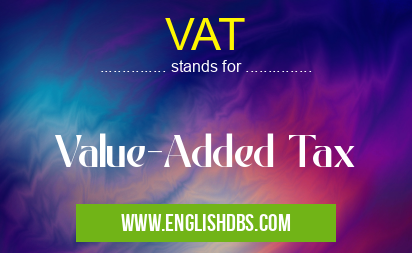What does VAT mean in TAX
Value Added Tax (VAT) is a form of taxation that is applied to goods and services consumed in the marketplace. The money generated by VAT helps maintain public services, such as healthcare and education, and also supports government development initiatives. It is one of the most important sources of revenue for governments around the world.

VAT meaning in Tax in Business
VAT mostly used in an acronym Tax in Category Business that means Value-Added Tax
Shorthand: VAT,
Full Form: Value-Added Tax
For more information of "Value-Added Tax", see the section below.
Benefits Of VAT
VAT serves as an effective means not only for generating revenue but also promoting economic growth because it encourages businesses to invest in new technologies or processes and increase efficiency by enabling them to recover any taxes paid along the supply chain during production. In addition, since all transactions made within the scope of VAT are traceable by government authorities; this system makes illegal activity much easier to detect and reduce fraud & corruption resulting in increased financial transparency & compliance with regulations. Finally, due to its multi-step method of taxation that assigns different rates based on goods & services provided – common goods like food items are taxed at much lower rates compared to luxury items – this system promotes equity among customers with varying purchasing power levels as well as ensures fairness between local businesses & foreign competitors operating in same markets.
Essential Questions and Answers on Value-Added Tax in "BUSINESS»TAX"
What is VAT?
Value-Added Tax (VAT) is a multi-stage tax on consumer spending that is applied to the value added at every stage of the supply chain, from production to final sale. VAT was introduced in 1954 as a way to increase government revenues and discourage the consumption of certain goods or services.
Who pays for VAT?
The end customer pays for VAT by adding an additional percentage on top of the sale price. In some cases, a business may choose to cover the cost of the VAT itself rather than passing it off to customers.
What are the current VAT rates?
The current UK rate of VAT is 20%. This rate applies to most goods and services unless specified otherwise by HMRC. Some items, such as food, books, children’s clothing and energy-saving materials are subject to reduced rates.
When do I need to register for VAT?
If your taxable turnover exceeds £85,000 in any 12 month period then you must register for VAT with HMRC within 30 days. You may also choose to voluntarily register if your turnover does not exceed this threshold.
Do I have to pay back overpaid VAT?
Yes, if you have overpaid on your VAT return then HMRC will require that you repay them when they review your records. It is important that businesses keep detailed records so that they can accurately track payments made and received.
How do I reclaim input tax?
Input tax can be reclaimed from HMRC either through adjustments within a new or amended(corrected)VAT return or through direct reclaims from earlier returns submitted prior to making any adjustments. However, it is important to note that input tax can only be reclaimed on goods purchased for use in business activities and not items bought for personal use.
Is there an age limit on reclaiming input tax?
No, there is no age limit on reclaiming input tax provided you meet all of the other criteria required by HMRC such as keeping accurate records etc. However, please note that input tax can only be reclaimed up until four years after when it was incurred.
Final Words:
In conclusion, Value-Added Tax (VAT) provides governments with an efficient way for raising revenue while stimulating economic growth and creating social equity among citizens with different purchasing power capabilities - making it an indispensable part of many countries’ financial systems worldwide.
VAT also stands for: |
|
| All stands for VAT |
